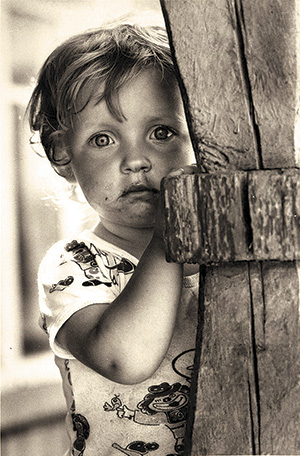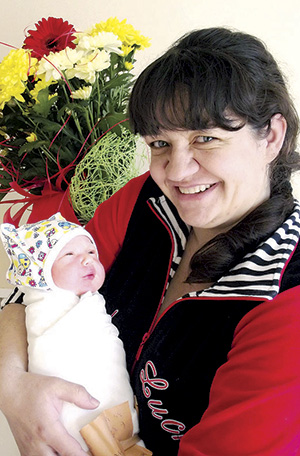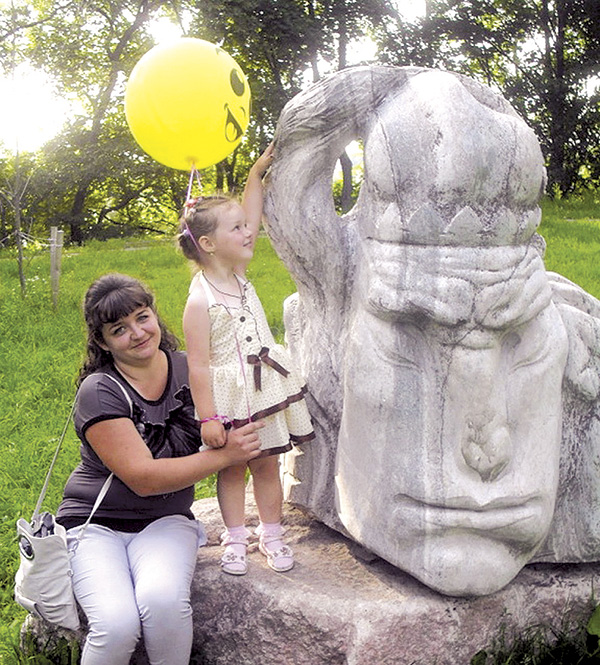
Yulia isn’t quite 3 years old in this photo
| 
Recently Yulia gave birth to her son Timur
|
Thirty years later, we have found Yulia. Her name is now Yulia Svirskaya. Married and living in Shklov, she works at the local post office. She has a daughter already and, on the eve of another Chernobyl anniversary, she has given birth to a son. To mark the happy event, the MT reporters visited the maternity ward with flowers and a blanket for the newly-born Timur. It’s difficult to recognise Yulia now except for the fact that her eyes are the same as depicted in the photo. They are truly expressive and piercing but now lacking in sadness: Yulia is happy. In December, she’ll turn 30 and does not remember the dreadful events of the past. “I was too little when this photo was taken. I remember only that my parents, brother, sister and granny Nastya (my father’s mother) moved from our native Chudyany to the Krugloe District. We were given a brick house, with four rooms and a kitchen, in the village of Klyapinichi; my parents still live there,” she explains.
Yulia’s mother, Lidia, was employed as a farm manager, while her father Mikhail began working as a driver. Like all others, the family needed to get used to the new place and really missed their homes. They used to visit on Radunitsa holiday — to attend the local cemetery where her father’s relatives are buried. Granny Nastya was also buried there. Yulia continues sadly, “In the first few years after the tragedy, many people came for Radunitsa anniversaries but there are not so many now.” She clearly remembers their village which was merry and friendly, “This was my husband’s home. We lived in his family house. We had our own House of Culture, an elementary school, a farm with a cowshed and four calf houses and around 500 head of cattle. After the disaster, we were not told the truth for a long time. However, by the summer, there was a rumour that our children were to be resettled in clean zones. I was pregnant with Yulia then and, offered the chance to recuperate at a sanatorium in the Mogilev District. While staying there, the Mogilev doctors were continually asking me about my health and, on learning that I already had two children — Sergey and Natasha — began to frighten me, saying that my third child could be born disabled which was very distressing for me. I contemplated a caesarean section but was persuaded by a visiting neighbour, Lyuda, to give birth naturally. She lives in Cherikov now and whenever I meet her on Radunitsa, I always thank her for Yulia, who was born healthy and beautiful.”

Yulia already had her own daughter Ksyusha
Lidia returned to Chudyany with the small baby Yulia as no one wanted to leave their homes. Soon afterwards the villagers received instructions to get rid of their cattle and close the wells. The local farm manager was prohibited to feed the cows with local forage: it was brought from neighbouring villages. Some time later, the district heads began visiting the village often, persuading people to move: the radiation in Chudyany was over 100 curies although this was kept from the villagers to avoid panic. Lidia and her husband Mikhail decided to resettle because of their children who began to frequently fall ill. Natasha suffered from sever headaches and often needed to consult the doctors in Mogilev and Minsk. “We sold the cow but took our pigs, hens and geese,” Lidia recollects. “22 families from our area moved to the Krugloe District but only five of them stayed. People and even the animals missed their homeland greatly. Before leaving Chudyany, we noticed that our cat Mulik had run away. We were reluctant to leave him when the village was to be destroyed. Luckily, both the cat and our dog Bosy were found in time.”
The Ganchurys settled well and now have no plans to move anywhere. Not long ago, they bought the house they received as resettlers. The couple are pensioners now but keep several pigs and hens. “We need to help our children and grandchildren,” they explain. Their children now live far away: Natasha works as a kindergarten teacher in Molodechno, having two children of her own, while Sergey lives in Mogilev. Yulia entered the Belarusian-Russian University after graduating from college. She met her future husband Sergey in Krugloe. The couple dated for two years and got married immediately after she got a job as an economic manager. Yulia recollects, “We initially lived with my parents in the Krugloe District but decided to settle in Shklov as my husband worked there. By that time, we had our daughter Ksyusha. When she was four, we took a loan and now live in a two-bedroom apartment of our own.” Ksyusha is seven now and her mother admits, “I’m happy. My husband wanted a daughter as the first baby — followed by a boy. Dreams come true and life is going on!”
By Olga Kislyak












